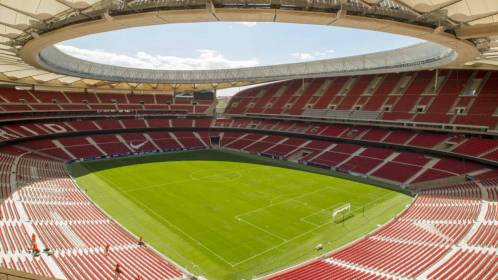The 2018-19 season saw an unlikely addition to the second division. Club de Fútbol Rayo Majadahonda, is a team from a leafy and affluent suburb of Madrid, that sits around 10 miles to the north west of the Spanish capital. Rayo was founded as recently as 1974, and prior to promotion to the second tier, had spent just five seasons in Segunda B.

The current settlement of Majadahonda can be traced back to the 1500s, and it was a village of around 200 houses when Cervantes name-checked it in Don Quixote. It was decimated during the Civil War, but by the late 1950s it had been rebuilt and had a population of around 3,000. A series of amateur clubs came and went during the 1950s & 60s before the current club was established in 1974. Rayo registered with the Castellana Federation on 7 June 1976, the same year that the local municipality developed land to the south of the town. The very basic Campo Municipal Cerro del Espino featured a small clubhouse, a dirt pitch and well, not a lot else. Rayo worked its way through Madrid’s regional leagues and reached the Tercera in 1987. By the mid-1990s, Rayo were contenders for promotion to Segunda B, and the municipality invested in the Cerro del Espino by building a new grandstand and installing the club’s first grass pitch. The new set up was inaugurated on 13 September 1995 with a friendly versus Atlético Madrid. Rayo & the municipality established ties with Atlético Madrid, which led to Atléti training at, and relocating the B Team to Cerro del Espino.

The main arena underwent substantial improvements in 1997, when Atlético Madrid signed a 50 year agreement with Rayo & the local municipality to manage and maintain the site. In return, Atléti invested 600m pesetas developing the the facilities, which now include an additional four full size pitches, accommodation for the Atléti’s academy and an Atléti superstore on the site of the old clubhouse. The main stand is 80 metres in length and sits on the north west side of the ground. It has its seating deck that is raised 6 feet above pitch level and 725 red seats sheltered under a white fibre-glass roof, that resembles a series on conjoined gazebos. Opposite the main stand is a thin strip of 825 open seats, whilst the south west end of the ground holds the most spectators, with 1700 housed on a large open deck of red seats. The Mini Estadio, as it is now named, has a capacity of 3,376.

Rayo first reached Segunda B in 1997-8. It was a season-long stay, which the club repeated in 2003-04. It would take Rayo a further 11 seasons to get back to the third tier, but within three seasons, a league title and promotion to La Segunda had been achieved. The requirements for hosting La Segunda matches have changed since the Mini Estadio last saw second tier football in 2000, when Atlético Madrid B’s stay came to an end. So much so that Rayo called upon the special friendship with Atléti, and will use the 67,000 seat Wanda Metropolitano for the first few months of the 2018-19 campaign.

Whether Rayo Majadahonda can attain the same level of success and stability that Madrid’s other suburbanites Alcorcón has achieved, remains to be seen. However, having come so far, so quickly, you can be sure that they are going to savour every minute of their first season at a national level.

1 thought on “Majadahonda – Mini Estadio Cerro del Espino”